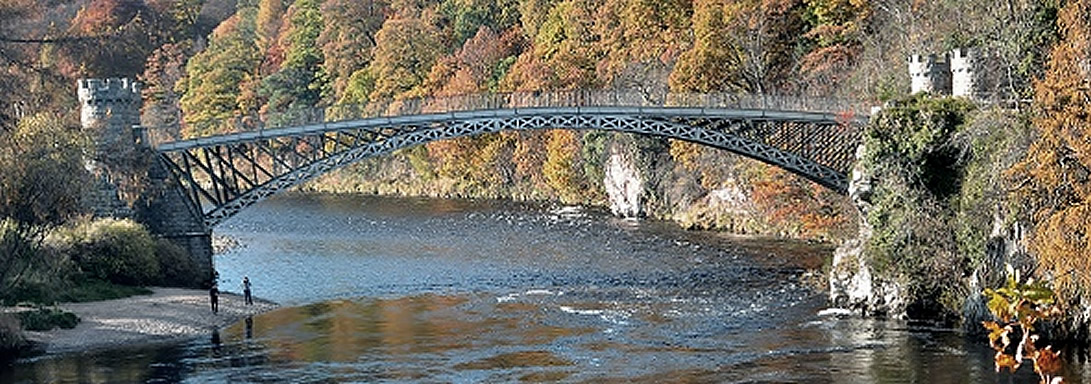
We are currently producing traditional Atlantic salmon flies for anglers going to the great destinations around the
North Atlantic and Spey flies for trout, bass and of course Atlantic Salmon.
For decades Ted has been the principal tier of flies
for Iceland bound anglers and the first tier of flies for Americans going to the Ponoi River in Russia.
Many of the old Canadian angling lodges are gone or converted to ZEC operations, but I still have logs of flies that were tied for anglers headed to the Restigouche, Moisie, Whale, and St Jean etc. I cherish the large Norwegian flies sent to me by Stan Bogdan and a small collection of originals tied by Arseneault. For more about Godfrey Salmon Flies and a glimpse of the old days: On the Restigouche
| GODFREY SPEY FLIES I |
SPEY FLIES II
|
The Spey type fly design of course originated on the banks of the Spey River in the Scottish Highlands. It's an extraordinary river valley with unique history due in part to relative isolation as it lays between two mountain ranges. The City of Aberdeen is the closest large city some 55 miles east over the Cairngorm Highlands as shown on the map of Rivers of East Scotland. The third largest and longest river in Scotland, the Spey is rather fast in the mid-river area around Craigellachie, but gentler on up by Grantown and again gentler and broader in the 12 miles of Gordon Castle water on down to Spey Bay. Strathspey (the river valley) is known for two things: A great salmon fishery and Scotch Whisky. This valley and the Moray area in general is the leading distiller of famed single malt scotch; casual visitors enjoy the river scenery, the history, and traveling and imbibing on the "Malt Whisky Trail".
The picture on top of this page is of the "Craig Bridge" on the Spey immediately above the small town of Craigellachie the home of James Shanks the noted mid-century guide and fly designer. His son George Shanks was even more famous as head Ghillie at Castle Gordon. He was in charge of a dozen guides who worked seven salmon beats on the lower Spey River. The early history going back to the 17th and early 18th century is indeed very murky. We must depend on scant 18th century articles in the Angling Gazette and the book, Autumns on the Spey by E. A. Knox, 1878. Knox's book describes the authentic early spey flies of the Shanks.
Orders are taken on a seasonal basis. Due to heavy spring demand for reels, fly orders are filled in the latter half of the year. To order call Ted at: Free shipping to the continental US on orders of $50 or more.
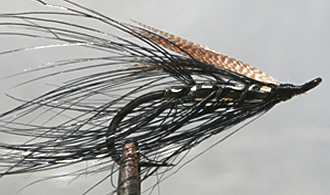
|
The Black Heron The Black Heron is much like the better know Gold Heron. This early design has no throat hackle and is simply a black and brown fly, but the ribbing is complex as is most of the old Spey side flies. Available in all sizes 2/0 - 8. Priced at $20.00 per 3 flies mixed sizes. |
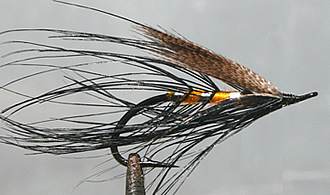
|
The Carron The Carron is another very old spey, but somewhat brighter with its light orange body. No doubt its named for the Carron Beat on Middle Spey River which is still a great destination for the avid angler looking for the true Scottish salmon fishing experience. Nearby accommodation: The Carron House This Really IS a great fly for trout and bass as it imitates crayfish really well. I use it and don't worry myself about any of the modern crafish imitation. Available in sizes 2/0 - 8. Priced at $20.00 per 3 flies mixed sizes. |
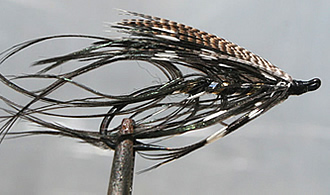
|
The Black King The Black King like the other King color pattern patterns sports "spey cock" hackle. The design is attributed to Mr. Charles Grant and available in sizes 2/0 - 6. Priced at $20.00 per 3 flies mixed sizes. fly tier. |
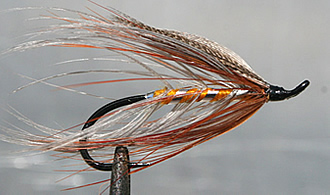
|
The Lady Caroline A very well know and an ancient fly design the first description of the Lady Caroline appears in a list given by Stoddart in 1847 bookAngler's Companion. The actual name is not given, but the pattern is right. Another source: The fly is named afterCaroline Elizabeth Gordon-Lennox who lived 1844-1934. Lady Caroline was most likely designed and tied by George Shanks My fly is tied in the fashion of JAJ Munro. Available in all sizes 2/0 - 8. Priced at $20.00 per 3 flies mixed sizes. |
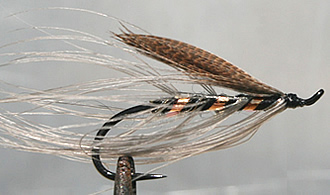
|
The Gold Heron Listed by Knox attributed to Geordie Shanks. Available in sizes 2/0 - 8. Priced at $20.00 per 3 flies mixed sizes. |
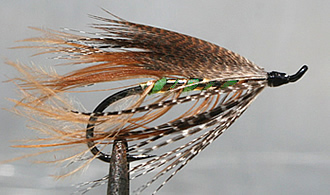
|
The Green King Described by Francis Francis in 1867 and gifted to him by Charles Grant an avid angler and fly designer. Fly is tied in the fashion of JAJ Munro of Aberlour-on-Spey. Available in sizes 2/0 - 6. Priced at $20.00 per 3 flies mixed sizes. |
All of the flies pictured here are tied on size 2 long shank English salmon hooks; that is about 1 1/4" long and would be considered normal for summer salmon angling. For Spring time angling up river on the Spey in the old days, spey flies were tied large, say 7/0 or 3 to 4 inches in length and thrown with the huge 20 foot rods for some of the largest salmon found anywhere in Europe.
I do fish spey patterns and on local waters, but in the smaller sizes: size 2 to size 8 hooks. I fish a size eight Lady Caroline for trout in our local Gunpower Falls River. For Bass I really like these flies especially on the Susquehanna north of Harrisburg, Pennsylvania. I don't use a 20 foot rod or even a 'switch', but a nice easy nine footer for five weight. On this river the old spey fly patterns in sizes four and six work just great for small mouth all summer long. They are just as effective as the touted Clousers or mundane woolies and I just like using a real classy fly.
Spey Flies on this page are available on the English long hooks in in the sizes given for each fly.
Free shipping on orders of $50.00 or more.
To order call Ted at:
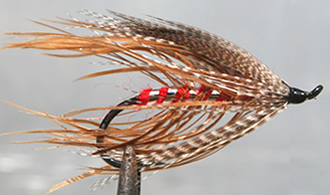
|
The Red King A vintage fly from JAJ Munro of Aberlour-on-Spey c1910-1920. This fly is pictured at Feathers Flies and Phantoms and tied by JAJ Munro. Avaiailabble in sizes 2/0 - 6. Priced at $20.00 per 3 flies mixed sizes. |
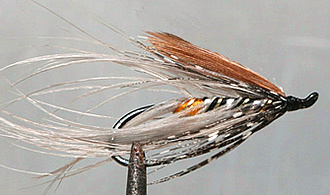
|
The Silver Heron The Silver Heron is seen in Garden's Catalog of 1917 and pictured at Feathers Flies and Phantoms by Colin Innes. Available in sizes 2/0 - 8. Priced at $20.00 per 3 flies mixed sizes. |
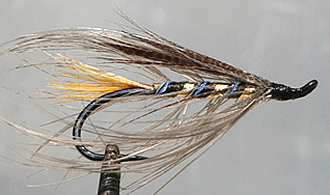
|
The Stoddart Spey This is Stoddart's No 1 spey fly from the Thomas Tod Stoddard's Angler's Companion to the Rivers anf Lochs of Scotland (1846). and known widely as the Stoddart Spey. Available in sizes 2.0 - 8. Priced at $20.00 per 3 flies mixed sizes. |
The myth of loss of the unique Spey Cock breed who's feathers are central to the tying of old spey flies is a gross exaggeration. Archebald Forbes writing in My Native River, 1896 promoted such a story about the uniqueness of the feathers and the mysterious loss of the birds. In reality, birds were reported by Augustus Grimble, The Salmon Rivers of Scotland vol 2, 1900. at Arndilly, Wester Elchies, Gordon Castle and so forth. Considered a weak breed, they were narrow breasted, poor of meat and survived better in warmer climes like Goodwood, Sussex, home of Duke of Richmond.
Any loss of birds mid-century might have been result of desperation during the Highland Potato Famine - 1846 to roughly 1856. During this period, approximately 30% of the Highland population emigrated principally to Canada and Australia.
The large, healthy looking bird pictured here shows the desired drooping, side tail feathers. They are also known in the trade as coque feathers. Today, very high quality black and to lesser extent red and brown feathers are available. Give John McLain at Feathers MC a try.
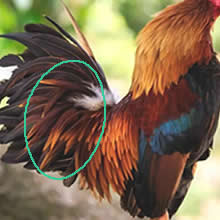
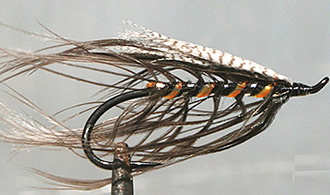
|
The Culdrain Culdrain is Gaelic for "corner with thorns" and is another design by Geordie or James Shanks listed in the Knox book. Culdrain with the Culdrain House (7 bedroom min-mansion) and Stead (farmstead) is near the Bogie R. a few miles south of Huntly and ruins of Huntly Castle the ancestral home of the Gordon Clan. This area is about 25 miles E. of the towns of Aberlour and Craigellachie on Spey. Also near by is the famed Deveron R., which is easier to fish than the Spey and has great fishing for both salmon and large brown trout. The Culdrain house build in 1846 by the Gordon family may have been constructed with the help of Geordie or his father James as they would have been the right age to pitch in. This fly is available in sizes 2/0 - 6 Priced at $20.00 per 3 flies mixed sizes. |
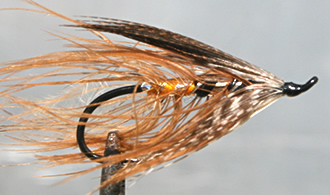
|
The Gold Riach If this name is Gaelic derived, it's pronounced REE'ach. This same Reeach spelling is that of Knox. Sometimes the Riach is tied per Knox, but often tied with only two turns of of gold beading between the wide wraps. I think it important to note that Garden catalogs show the Gold Riach with the three gold "Reeach" beadings! | |
|
Note that Braeriach is a near by peak in the Cairngorms. Its the third largest and certainly the coldest with snow rarely disappearing from the north face. Braeriach the mountain from Braigh (summit) and Riabhach (speckled) so the Gold Riach would be the Gold Speckled or Brindled Fly. Some believe the Gold Riach is named after a Mr. or Ms. Riach, but this needs further research. The Gold Riach shows up in most catalogs of spey flies and is perhaps the most popular spey fly accounting for thousands of fish according to log books. It is available in sizes 2/0 - 6. Priced at $20.00 per 3 flies mixed sizes. | ||
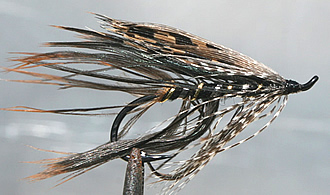
|
The Spey Dog Francis Francis described this fly in his 1867 book and its a lovely fly with heavy wings. Available in sizes 2/0 - 6. Priced at $20.00 per 3 flies mixed sizes. |
Little is known of George and his father James Shanks other than what is given in books by Archibald Forbes writing in 1896 and Augustus Grimble in 1900. James was a renownd gillie and tackle maker with a pool named for him that is located just below the Cragellachie A-941 Bridge. His son George pictured here with the Duke was for decades the head ghillie at Gordon Castle. Of their lives in detail, little has been written down, but they must have been very well know to visiting anglers including Mr. Knox who only spoke of these two men as "Shanks" rather than individually.
Over the interceding 150 years the original spey flies of James and George as seen in this framed set by John Sweney were lost to fish, sold off or given away. What remains are seen in the frame at right. Ever since that time, many fly tiers have tried to ‘codify' the patterns and the most severe adaptation is seen in the flies of Price Tennatt. His neat and artistic presentations have the wings together as in a beetle back. The original and flamboyant, mid-18th century Shanks' flies are shown here. Click on the frame for a larger view.
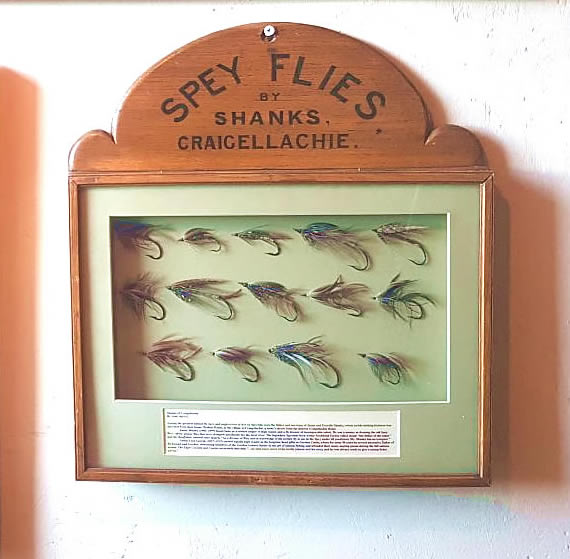
This picture is from an article about the Craigellache Hotel; a nice piece with pictures by Callum Watt. The frame of flies deserves further research, but one thing stands out: The style of the flies -- such variety. Note the two small flies on the right; they are approximately size 2 and have similar appearance to mine.

The "Purpy" also known as "the Gold Purple Fly": This is an ancient pattern with no known origin, but well accepted as a "standard" on the river. Here are all the available hook sizes of this type of fly that I produce - Sizes: 2/0, 1/0, 1, 2, 4, and size 6.
The above flies are tied with so called "Spey Cock hackle feathers" in color red-brown. The feather is tied-in in the traditional, Speyside fashion; that is, the feather butt end tied in at the end of the body and then the feather wound forward along side of the tinsel rib. This tying method enables the feather fibers to stick out perpendicular to the hook. I suspect this was done to make the fly present a larger silhouete in fast, high water of Spring. Available in sizes 2/0 - 6. Priced at $20.00 per 3 flies mixed sizes.
| Next:
SPEY FLIES II |
|
The Godfrey NewsBrief Simply email us at "tedgodfreys@comcast.net"Subject: "NewsBrief Please" The NewsBrief is sent out every month or so and provides information about new products and updates |